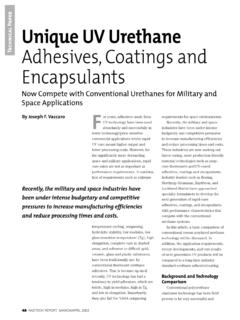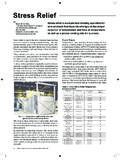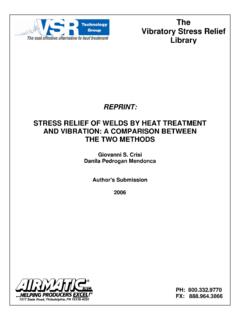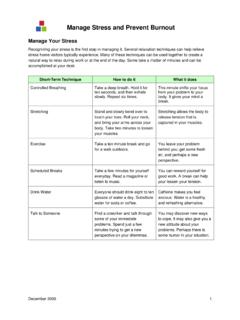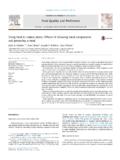Transcription of Stress Management Via Low Modulus Urethane …
1 Page 1 of 4 Stress Management Via Low Modulus Urethane Adhesives For electronic applications BY JOSEPH F. VACCARO, APTEK LABORATORIES, INC., VALENCIA, CA AS SEEN IN HYBRID CIRCUIT TECHNOLOGY OCTOBER 1990 The mismatch of the thermal expansion coefficients of various components and substrates to be bonded has long been a cause for cracking and delamination problems. These problems are especially evident in devices/assemblies containing ceramic, glass, or other fragile materials that will fracture during the Stress buildup from thermal cycling.
2 The electronics industry has relied primarily on silicone-based systems to resolve Stress -related problems. Although silicones have demonstrated success in relieving Stress , their inherently poor adhesion and release agent characteristics have created additional costly handling steps for production operations such as: application of a primer required to improve adhesion, extensive masking procedures to avoid silicone contamination of areas where the bonding of other adhesives or coatings is critical, demasking procedures, and solder dewet problems for subsequent process steps.
3 Advancements in Urethane technology have led to the development of adhesives and encapsulants that approach the cleanliness and operating temperature range of silicones, yet display superiority in the following areas: substrate adhesion primer not always required, long-term low temperature performance, moisture resistance in thin cross sections, abrasion resistance, and overall physical strength (tensile/elongation/tear strength). Introduction This article discusses how low Modulus Urethane adhesives have been used to resolve Stress and heat Management problems while displaying improved handling and processing qualities over silicones.
4 The demand for more sophisticated and reliable electronic devices and assemblies has presented increasingly more difficult problems for materials and design technologists as well as for manufacturing engineers. Problems relating to thermal and Stress Management have become major concerns as these devices/assemblies are required to perform many more electronic functions in a more confined space. To complicate matters, these devices/assemblies are hybrid in nature and require the use of different materials that must interface with each other during operational life.
5 The generation of heat from both internal (for example, biased condition) and external sources cause these varied materials to expand at widely different rates. The coefficients of thermal rates expansion of materials typically used in the manufacture of state-of-the-art electronic devices and assemblies are as follows: CTE (XY) of various materials (typical values) Material CTE (in/in/ C) x 10-6 epoxy laminate 18-20 Al2O3 ceramic 5-6 Solder 24-26 Glass 3-5 fused quartz aluminum 23-25 copper 18-20
6 70% epoxy adhesive (below Tg)* 25-35 70% silicone adhesive (above Tg)* 140-155 70% Urethane adhesive (above Tg)* 140-155 *each is 70% filled At the interfacial surfaces of these materials, significant forces and stresses build up as these materials expand and contract (in effect, push and pull on each other) at grossly different rates. Obviously, something has to give, and the stresses are relieved through distortion, cracking, and fatigue.
7 The challenge for the design engineer is to minimize or absorb the forces of Stress to greatly reduce the possibility of cracking and related failures. Figure 1, a qualitative way to screen for Stress absorbing adhesives by bonding materials with gross mismatches in CTE. Page 2 of 4 Design Considerations In order to properly design a hybrid system, one must review the application and consider the following, which is not an all-inclusive list: Temperature excursion limits ( T), T-cycle vs.
8 T-shock, operational and test conditions, materials/components required, dimensional limitations, atmospheric or vacuum environments, heat buildup and dissipation, areas of Stress buildup and relief, production oriented, processing steps and times, and electrica11y insulating/electrically conductive. For each application, the requirements for most of the previously stated concerns will have been specified for the design engineer at the onset of the project. When designing for Stress Management , the key concern is the extreme temperature limits ( T) that the assembly will endure during operation and/or testing.
9 Simply stated, the T is the major driving force for most of the dynamics leading to Stress buildup within the assembly. Minor sources of Stress may result from handling, assembly, and mechanical shock. Stress Absorbers However, there are other considerations besides thermal expansion properties that should be analyzed when resolving Stress -related problems. Since it is virtually impossible to perfectly match up the CTEs of all the materials that contact each other, an alternative design strategy is to utilize a Stress absorber.
10 Stress absorbers are low- Modulus , high-elongation materials typically used as adhesives or encapsulants at junctions of high Stress . They absorb stresses mainly by taking up the thermodynamically-caused deflection of the adjoining substrates during thermal cycling. They, in essence, uncouple the bonded substrates, allowing for more freedom to move without much constraint. At the same time, the adhesive /encapsulant itself must not impart Stress back to the substrates or cracking/failure will result.
